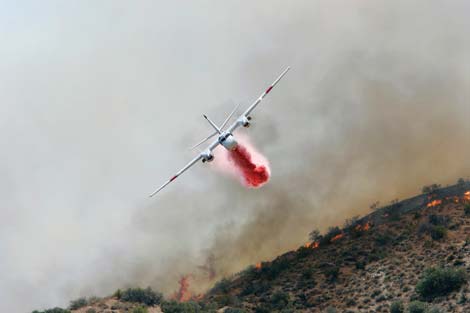Fire season is here

“We’re starting earlier than normal,” said CAL FIRE spokesman Eric Hoffman, regarding the beginning of the fire season.
Photos Courtesy of the California Department of Forestry and Fire Protection.
Cover Photo by Ryan Lely

Sonoma Valley’s recent rain and cool weather may have taken locals’ minds off the wildfires in Santa Cruz, but don’t be fooled – we’re in for a long 2008 fire season.
“We’re starting earlier than normal,” said CAL FIRE spokesman Eric Hoffman. “A couple of winters back we started later – we were really rolling into fire season around June 20. … [But] this year, we are experiencing the fires earlier, so we are responding accordingly.”
From the state agency’s point of view, fire season means hiring seasonal employees and readying CAL FIRE stations and aircraft, for the anticipated summer onslaught. But it also means enlisting the public’s help (and input) in keeping local homes safe through responsible planting and planning.
Since January, CAL FIRE and the county’s roads department have been inspecting and helping clear underbrush along Trinity and Cavedale roads – “fuel reduction,” in firefighter-speak. A similar effort will soon be taking place on Lovall Valley Road.
“What we do is we pick target areas,” Hoffman said. “They might last a year or be ongoing projects. Once we get those folks out there educated, we’ll pick another area.”
A plan in place
Another effort is the Community Wildfire Protection Plan, sponsored by “Fire Safe Sonoma.” The group is holding county-wide meetings through June 4 so homeowners and residents can contribute to the plan, noting special challenges of which non-residents may be unaware. Valley residents can attend a session from 7–9 p.m. Friday, May 30 at the Glen Ellen Fire Station, 13445 Arnold Dr., Glen Ellen.
Fire Safe Sonoma also offers a 16-page booklet, “Living With Fire In Sonoma County,” on its Web site, http://firesafesonoma.org/.
Nonflammable hardscaping and other outdoor features
Mulch is highly recommended as a means of reducing water evaporation, but it can become a nightmare during a fire. Keep mulch moistened to lower the risk of its being set on fire by blowing sparks, tossed cigarettes or still-glowing charcoal in a barbecue grill.
Choose a type of mulch low in resin content and apply it in layers to suppress weeds, but make the layers think enough so that the pieces will not smolder for hours on end.
Create fuel breaks by installing a water feature (ideally a pool) and using nonflammable materials for fencing and the like. Cover open ground with rock, brick, paving or anything else that is not fire-prone.
What homeowners can do
The right landscaping can help protect your home from going up in flames. What is known as fire-resistant landscaping has essentially three components: a defensible space that makes it difficult for a fire to leapfrog onto your house, hardscape features such as rock and stone in lieu of flammable materials and plantings that are slow to catch fire.
Defensible space
Homeowners should remove or at least reduce the amount of flammable material within a minimum of 30 feet around the house and any outlying structures. This buffer zone, which ideally should extend to 100 feet, will serve as a fuel break that will keep a fire at a slow pace and low temperature until it can be extinguished. In the event of a wildfire, it can also allow firefighters enough room to maneuver so they can focus on saving the house itself.
It was the absence of defensible space that wreaked so much destruction during the 1991 Oakland Hills Fire that devastated some 3,000 homes. The insatiable blaze was further fueled by eucalyptus trees, which are notoriously flammable.
Specific tasks:
Clear or trim vegetation from around the house – especially foundation plantings – that could encourage fire or allow fire to “leapfrog” to another spot.
Clean debris from gutters and roof. Needles and leaves on the roof and in the gutters provide tinder for blowing sparks.
Remove tree limbs hanging over the roof or within 15 feet of the chimney as well as any trees beneath electrical lines.
Reduce the number of trees until they are 10 feet apart at the crowns; keep debris out of the ground below.
Keep your yard raked, mowed (to a maximum of eight inches, especially during the dormant season) and free of brush.



